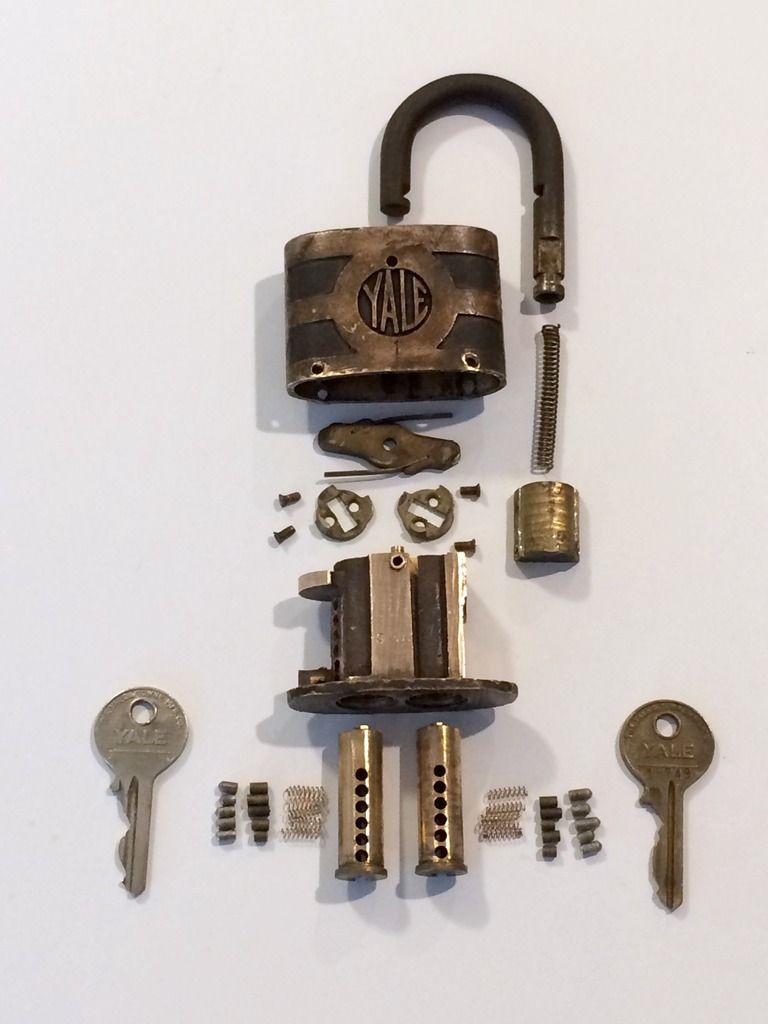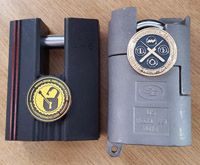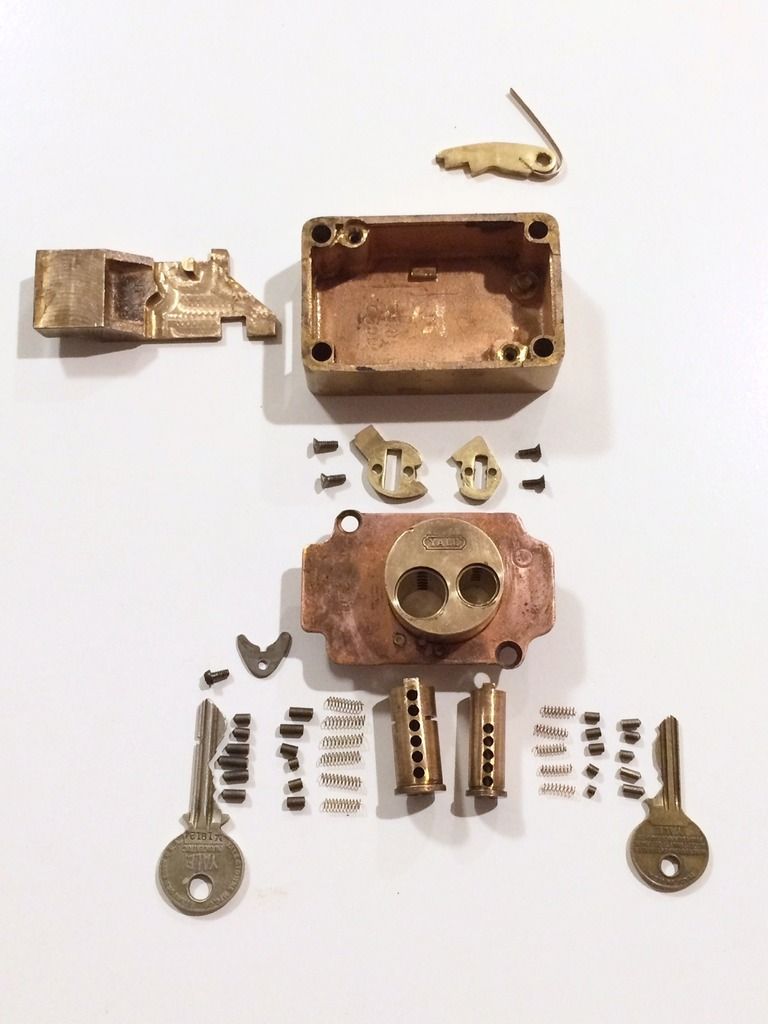|
Information about locks themselves. Questions, tips and lock diagram information should be posted here.
 by Robotnik » 10 Apr 2016 22:19 by Robotnik » 10 Apr 2016 22:19
As many photos as I've seen of bicentric Yale padlocks, I can't recall ever seeing one gutted. This week however, I came into possession of a (badly) broken one that nonetheless had an open shackle. As a result, I decided to do something about the lack of gutted pics while repairing it. Hopefully this layup gives a good idea of how these padlocks work (at least in shared custody format). 
-
Robotnik
- Supporter

-
- Posts: 668
- Joined: 3 Aug 2014 16:21
- Location: Portland, Oregon, United States
 by LocksportSouth » 11 Apr 2016 6:48 by LocksportSouth » 11 Apr 2016 6:48
Awesome! Thanks  I'm currently watching one of these on eBay. One thing I can't quite figure out is how the actuator works at the top to require both keys in order to turn that top plate - or more specifically, how it prevents just one correct key from rotating it. It's probably one of those things that's easier to work out when you have it in your hands  . Regardless, awesome "exploded diagram" of lock insides. As you say, it's the first time I've seen out of these gutted
-

LocksportSouth
- Supporter

-
- Posts: 475
- Joined: 20 Nov 2015 21:20
- Location: UK
 by Robotnik » 11 Apr 2016 17:07 by Robotnik » 11 Apr 2016 17:07
I can't tell you from firsthand experience how the actuator/locking plate functions on a DC version of the Bicentric padlock - paid more than I'd have liked for mine, and have roughly zero interest in taking it apart  . As far as I know, the cam on the guard cylinder acts as something of a blocking plate for the actuator rather than operating it like in the shared custody version. Guard key's turned roughly 25 degrees (doesn't feel like it's under spring tension at all), then the operating key can be turned. I have disassembled a Bicentric DC safe deposit lock; I'll post some pics of that when I find them. Good luck on picking up the one on eBay now; thought of you when I saw that.
-
Robotnik
- Supporter

-
- Posts: 668
- Joined: 3 Aug 2014 16:21
- Location: Portland, Oregon, United States
 by LocksportSouth » 11 Apr 2016 17:13 by LocksportSouth » 11 Apr 2016 17:13
Thanks! There were some replied on the other forum too so I think I follow along now. I mistook this one for a DC lock so I was trying to figure out how it operated, but it makes a lot more sense knowing it's shared custody, my bad. Thank you also! It looks very nice but the start price is a fair bit plus whatever it bids to so I'll have to keep the fingers crossed and keep an eye on the wallet, hah! 
-

LocksportSouth
- Supporter

-
- Posts: 475
- Joined: 20 Nov 2015 21:20
- Location: UK
 by Robotnik » 12 Apr 2016 18:43 by Robotnik » 12 Apr 2016 18:43
 Found the shot of the disassembled Yale 6600 dual custody safe deposit lock. When the guard cylinder (smaller plug) is turned, its tailpiece a) lifts the lever that blocks the bolt from retracting, and b) allows the renter cylinder to turn with the key (which throws the bolt).
-
Robotnik
- Supporter

-
- Posts: 668
- Joined: 3 Aug 2014 16:21
- Location: Portland, Oregon, United States
 by Mudman » 12 Apr 2016 22:06 by Mudman » 12 Apr 2016 22:06
That's a really cool lock! Thanks for sharing.
-
Mudman
-
- Posts: 45
- Joined: 9 Mar 2016 21:28
- Location: California, USA
 by Squelchtone » 13 Apr 2016 3:00 by Squelchtone » 13 Apr 2016 3:00
Very nice composition Robotnik! I like the exploded parts view feel.
on the padlock, can you confirm that you do in fact need both keys to unlock the padlock? I thought before they invented master wafers to master key locks, Yale had the change key keyhole and the master key keyhole and either key alone would open the lock, or is this padlock specially made to be opened by two key holders present at the same time?
Thanks,
Squelchtone
-

Squelchtone
- Site Admin
-
- Posts: 11325
- Joined: 11 May 2006 0:41
- Location: right behind you.
 by GWiens2001 » 13 Apr 2016 6:30 by GWiens2001 » 13 Apr 2016 6:30
Squelchtone wrote:Very nice composition Robotnik! I like the exploded parts view feel.
on the padlock, can you confirm that you do in fact need both keys to unlock the padlock? I thought before they invented master wafers to master key locks, Yale had the change key keyhole and the master key keyhole and either key alone would open the lock, or is this padlock specially made to be opened by two key holders present at the same time?
Thanks,
Squelchtone
They have made both styles, Squelchtone. The type you describe is called "shared custody", while the ones requiring both keys to open are dual custody. Dual custody is more rare. Gordon. Just when you finally think you have learned it all, that is when you learn that you don't know anything yet.
-

GWiens2001
- Site Admin
-
- Posts: 7587
- Joined: 3 Sep 2012 16:24
- Location: Arizona, United States
 by Robotnik » 17 Apr 2016 15:37 by Robotnik » 17 Apr 2016 15:37
Squelchtone wrote:Very nice composition Robotnik! I like the exploded parts view feel.
on the padlock, can you confirm that you do in fact need both keys to unlock the padlock? I thought before they invented master wafers to master key locks, Yale had the change key keyhole and the master key keyhole and either key alone would open the lock, or is this padlock specially made to be opened by two key holders present at the same time?
Thanks,
Squelchtone
As Gordon touches on, the padlock pictured above is shared custody/master keyed - either key will open; each plug's tailpiece will work the actuator. I've never disassembled a dual custody padlock (needs both keys to operate), though I do have one in my collection.
-
Robotnik
- Supporter

-
- Posts: 668
- Joined: 3 Aug 2014 16:21
- Location: Portland, Oregon, United States
 by kwoswalt99- » 18 Apr 2016 19:34 by kwoswalt99- » 18 Apr 2016 19:34
Maybe mine is a DC lock.  What is broken in that first one? Any chance of fixing it?
-
kwoswalt99-
-
- Posts: 1218
- Joined: 17 Mar 2015 15:35
- Location: Somewhere.
 by Robotnik » 19 Apr 2016 1:02 by Robotnik » 19 Apr 2016 1:02
kwoswalt99- wrote:Maybe mine is a DC lock.  What is broken in that first one? Any chance of fixing it?
It's already fixed and re-assembled. Shackle stop/guide on the heel side of the case was punched in, freezing the shackle in place (open, fortunately), and one of the cylinders was inoperable with a broken spring and stuck pin.
-
Robotnik
- Supporter

-
- Posts: 668
- Joined: 3 Aug 2014 16:21
- Location: Portland, Oregon, United States
 by hdp160 » 19 Apr 2016 1:38 by hdp160 » 19 Apr 2016 1:38
Thanks for posting these pictures. Really helps in understanding what's going on. And the explanation of dual and shared custody very useful.
-
hdp160
-
- Posts: 28
- Joined: 1 Dec 2010 16:49
 by peterwn » 11 Jul 2016 5:08 by peterwn » 11 Jul 2016 5:08
Squelchtone wrote:Very nice composition Robotnik! I like the exploded parts view feel.
on the padlock, can you confirm that you do in fact need both keys to unlock the padlock? I thought before they invented master wafers to master key locks, Yale had the change key keyhole and the master key keyhole and either key alone would open the lock, or is this padlock specially made to be opened by two key holders present at the same time?
Thanks,
Squelchtone
This is interesting. The first multiplex masterkey system was provided by Yale for the American Surety Building (100 Broadway NY City) in 1896 and used the GA, etc profiles (source Billy Edwards in a alt.locksmithing comment years ago). This would have used master wafers. Multiples systems have been called 'Surety' systems and that has been corrupted in some places to 'security systems'. So master wafers must have been devised prior to 1896. I did a quick look for the original pin tumbler masterkeying patent (most probably issued to Yale) but without success. Yale grand masterkeyed cylinders apparently originally used two wafers per chamber (which meant there would have been 726 incidental masterkeys for a 6 pin cylinder in addition to the grand master, sub master and change keys). I had always assumed that Yale bicentric cylinders were a 20th century invention, rather than invented soon after the pin tumbler cylinder itself. It would be interesting to know if any of the original 1896 cylinders remain in use, but that would seem highly unlikely.
-
peterwn
-
- Posts: 161
- Joined: 22 Aug 2010 23:31
Return to Locks
Who is online
Users browsing this forum: No registered users and 4 guests
|
